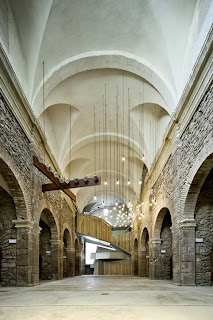The facory reconstruction region-can ricart recalls me to introduce 798 Art Zone in Beijing. 798 Art Zone is also a thriving artistic community, among 50-year old decommissioned military factory buildings of unique architectural style. It is often compared with New York'sGreenwich Village or SoHo.
The Dashanzi factory complex began as an
extension of the "Socialist Unification Plan" of military-industrial
cooperation between the Soviet Union and the newly formed People's Republic of
China. By 1951, 156 "joint factory" projects had been realized under
that agreement, part of the Chinese government's first Five-Year Plan. However
the People's Liberation Army still had a dire need of modern electronic
components, which were produced in only two of the joint factories. The
Russians were unwilling to undertake an additional project at the time, and
suggested that the Chinese turn to East Germany from which much of the Soviet
Union's electronics equipment was imported. So at the request of then-Premier
Zhou Enlai, scientists and engineers joined the first Chinese trade delegation
to East Germany in 1951, visiting a dozen factories. The project was
greenlighted in early 1952 and a Chinese preparatory group was sent to East
Berlin to prepare design plans. This project, which was to be the largest by
East Germany in China, was then informally known as Project # 157.
The architectural plans were left to the
Germans, who chose a functional Bauhaus-influenced design over the more
ornamental Soviet style, triggering the first of many disputes between the
German and Russian consultants on the project. The plans, where form follows
function, called for large indoor spaces designed to let the maximum amount of
natural light into the workplace. Arch-supported sections of the ceiling would
curve upwards then fall diagonally along the high slanted banks or windows;
this pattern would be repeated several times in the larger rooms, giving the
roof its characteristic sawtooth-like appearance. Despite Beijing's northern
location, the windows were all to face north because the light from that
direction would cast fewer shadows.
The chosen location was a 640,000 square
metres area in Dashanzi, then a low-lying patch of farmland northeast of
Beijing. The complex was to occupy 500,000 square metres, 370,000 of which were
allocated to living quarters. It was officially named Joint Factory 718,
following the Chinese government's method of naming military factories starting
with the number 7. Fully funded by the Chinese side, the initial budget was
enormous for the times: 9 million rubles or approximately 140 million RMB (US $
17 million) at today's rates; actual costs were 147 million RMB.











.jpg)